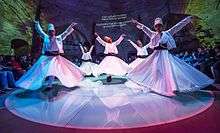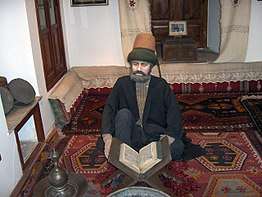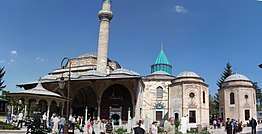Mevlevi Order
The Mevlevi Order or Mawlawiyya (Turkish: Mevlevilik or Mevleviyye; Persian: طریقت مولویه) is a Sufi order that originated in Konya (modern-day Turkey; formerly capital of the Anatolian Seljuk Sultanate) and which was founded by the followers of Jalaluddin Muhammad Balkhi Rumi, a 13th-century Persian poet, Sufi mystic, and Islamic theologian.[1] The Mevlevis are also known as the 'whirling dervishes' due to their famous practice of whirling as a form of dhikr (remembrance of God). Dervish is a common term for an initiate of the Sufi path; whirling is part of the formal sema ceremony and the participants are properly known as semazens.[2]
 | |
| Abbreviation | Mevlevi |
|---|---|
| Formation | 1312 |
| Type | Dervish Order |
| Headquarters | Konya, Turkey |
Makam Chalabi (Chief Master) | Faruk Hemdem |
Key people | Shams Tabrizi – Patron Saint Rumi - Patron Saint Sultan Veled - Founder |
| Website | |
| Mevlevi Sema Ceremony | |
|---|---|
 Hodjapasha Culture Center is a restored Ottoman hamam (Turkish bath) in Istanbul's Sirkeci district now used for performances of the Mevlevi (whirling dervish) sema. | |
| Country | Turkey |
| Reference | 100 |
| Region | Europe and North America |
| Inscription history | |
| Inscription | 2008 (3rd session) |
In 2008, UNESCO confirmed "The Mevlevi Sema Ceremony" as amongst the Masterpieces of the Oral and Intangible Heritage of Humanity.[3]
Principles and practices

| Part of a series on |
| Sunni Islam |
|---|
 |
In terms of Ihsan |
|
|
|
Lists |
|
|
Approximately 750 years old, the Mevlevi Order is a living tradition based on the teachings of Rumi, who is perhaps Iran and Turkey’s most celebrated poet and who is also venerated as a saintly mystic within Islam. Rumi’s friend and spiritual mentor, Shams of Tabriz, is also revered within the order and within Sufism more widely.[4]
Rumi said, "As long as I have life, I am the slave of the Quran. I am dust at the door of Muhammad the Chosen",[5] and the Mevlevi path is based firmly on Islamic principles. Kabir Helminski, a Mevlevi shaikh, writes 'It is a rigorous path of initiation and service continually adapting itself to changing circumstances and times.... Mevlevis have always been progressive and liberal in spirit while at the same time conserving the best of tradition.'[6]
The Mevlevis insist that love is at the centre of Islam. Mevlevi shaikh Şefik Can writes, 'Rumi tells us to take the love of God to the forefront, to abstain from being attached to the letter of the law rather than the spirit of it, to find the essence of the faith, and to raise our faith from the level of imitation to the level of realization.'[7]
In addition to obligatory Islamic worship, some of the main spiritual practices within the Mevlevi Order are as follows:
- Dhikr: invocation of the Divine Names which is believed to purify the heart
- Sema (sama): the whirling ceremony
- Study of the Quran and Rumi’s works (especially his poetic masterpiece the Mathnavi)
- Spiritual conversation led by the shaikh (sohbet)
- Meditation (known as muraqabah in Islam)
- Adab (developing courtesy and mindfulness)[8]
Sema
Rumi mentions whirling in a number of his poems. In one ghazal in the Divani Shamsi Tabriz he says:
Those who turn in the direction of prayer,
whirl in both this world and the next.
Pay heed when a circle of friends whirl,
circling round and round, the Kaaba is the center.
If you wish a mine of sugar, it is there;
and if you wish a fingertip of sugar, it is gratis.[9]

Origins of Sema
According to a popular story, Rumi was first inspired to whirl when he heard the hammering of the goldsmiths in Konya’s bazaar,[10] however, Mevlevi historian Abdülbâki Gölpınarlı believed that Rumi must have learnt whirling from Shams of Tabriz.[11] Şefik Can claimed that whirling was practiced among Sufis at least as early as Abu Sa’id Abu’l-Khayr (d. 1049).[12] Though they have cultivated it to the highest degree, Mevlevis are not the only Sufis who practice whirling, and Kabir Helminski suggests primordial origins: ‘The practice of whirling may have its origins in the timeless shadows of Central Asian spirituality where shamans used it to induce altered states of consciousness.’[13]
Method and symbolism
Sema (or sama) is traditionally practised in a semahane (ritual hall) according to a precisely prescribed symbolic ritual with the semazens whirling in a circle around their shaikh. Semazens whirl using their right foot to propel themselves in a counter-clockwise circle, whilst their left foot remains rooted to the floor acting as an axis about which the semazen turns. Both arms are extended and raised to the level of the head, with the right palm pointing upward (believed to be receiving Divine grace) and the left palm pointing downward (believed to channel that grace to the world). With each 360° turn, the semazen is inwardly chanting “Allah” – a form of dhikr.[14]
The semazens enter wearing a black cloak (hırka) symbolizing death and the grave, which they remove before whirling. On their heads they wear a tall, brown hat known as a sikke, which symbolizes the tombstone and the death of the ego (a version of the "Sikke" is also worn by the Bektashi). Once their cloaks are removed, their long white robes (tennûre) and white jackets (destegül – meaning ‘bouquet of roses’) become visible. Both are symbols of resurrection.[15]
Structure of the ceremony
Naat-i Sharif – The naat marks the beginning of the ceremony in which a solo singer offers a eulogy to the Prophet Muhammad. It is concluded with a taksim (improvisation) on the reed flute (ney), which symbolises the Divine breath that gives life to everything.
Devr-i Veled – The Sultan Veled walk involves the semazens walking slowly and rhythmically to the peshrev music. After slapping the ground forcefully (representing the Divine act of creation when God said 'Be!' according to the Quran), they make a circuit in single file around the hall three times, bowing first to the semazen in front of them, and then to the semazen behind them as they begin each circuit. The bow is said to represent the acknowledgement of the Divine breath which has been breathed into all of us and is a salutation from soul to soul. The dervishes then remove their black cloaks.
The Four Salams – The Four Salams (Selams) form the main part of the ceremony and are distinct musical movements. According to Dr. Celalettin Celebi and Shaikh Kabir Helminski, ‘The first selam represents the human being’s birth to Truth through knowledge, and through his awareness and submission to God. The second selam represents the rapture of the human being while witnessing the splendour of creation and the omnipotence of God. The third selam is the transformation of rapture into love, the sacrifice of mind to love. It is annihilation of the self within the Loved One. It is complete submission. It is unity.... The fourth selam is the semazen’s coming to terms with his destiny. With the semazen’s whole self, with all his mind and heart, he is a servant of God, of God’s books and His prophets – of all Creation.’
Quranic recitation – The ceremony concludes with a recitation from the Quran, which normally includes the following verse: God is in the East and West. And wherever you turn, there is the face of God. (Quran 2:115)[16]
History

Early expansion
The order was established after Rumi’s death in 1273 by his son Sultan Veled and Husameddin Chelebi (who inspired Rumi to write the Mathnavi).[17] Like his father, Sultan Veled is celebrated for his poetry. Lyrics he wrote are often sung during the sema ceremony itself,[18] and both he and Husameddin Chelebi are honoured within the order as accomplished Sufi mystics in their own right. It was they who had Rumi’s mausoleum built in Konya, which to this day is a place of pilgrimage for many Muslims (and non-Muslims). A number of Rumi’s successors, including both Sultan Veled and Husameddin Chelebi themselves, are also buried there. Their personal efforts to establish the order were continued by Sultan Veled’s son Ulu Arif Chelebi.[19]
During the Ottoman period, the Mevlevi order spread into the Balkans, Syria, Lebanon, Egypt, and Palestine, especially in Jerusalem. The Bosnian writer Meša Selimović wrote the book The Dervish and Death about a Mevlevi dergah in Sarajevo. Eventually, there were as many as 114 Sufi lodges, the order becoming well established within the Ottoman Empire when Devlet Hatun, a descendant of Sultan Veled, married Bayezid I. Their son Mehmed I Çelebi became the next sultan, endowing the order, as did his successors, with many advantages. Many of the members of the order served in various official positions within the caliphate.

The Çelebis
To this day, responsibility for overseeing the Mevlevi Order is passed down through the generations of Rumi’s male descendants. The head of the order is referred to as Çelebi (Chelebi) which means ‘man of God’ or ‘noble, courteous’ according to Mevlevi historian Abdülbâki Gölpınarlı.[20] The current Çelebi is Faruk Hemdem Çelebi. He is also president of the International Mevlana Foundation (UluslararasI Mevlânâ Vakfi), a Turkish cultural and educational foundation managed by his sister and vice-president Esin Çelebi Bayru. Shaikhs, who have the authority to teach Mevlevi practices and philosophy, are appointed by the Çelebi.
Artistic heritage
Rumi’s Mathnavi and Diwan-e Shams-e Tabrizi[21] are considered masterpieces of Persian literature, and throughout the centuries the Mevlevi Order has continued its long-standing association with the arts in Turkey. Apart from the works of Rumi and Sultan Veled, other famous literary works by Mevlevis include influential commentaries on Rumi’s Mathnavi by Ismāʿil Rusūhī Ankarawi (d. 1631) and Ismāʿil Ḥaqqı Burṣalı (d. 1724), the latter also being ‘a fine mystical poet’ in his own right.[22] The most celebrated Mevlevi poet, after Rumi and Sultan Veled, is Shaykh Ghalib Dede (d. 1799), the author of Hüsn ü Aşk and ‘perhaps the last true master of Turkish classical poetry’ according to scholar Annemarie Schimmel.[23] Both Ghālib Dede and Ankarawī are buried at the Galata Mevlevihanesi.
A significant number of the most celebrated Turkish musicians have been Mevlevis, and during the Ottoman era the Mevlevi Order produced a great deal of vocal and instrumental music. Mustafa Itri (1640–1712), an Ottoman-Turkish musician, composer, singer and poet, is regarded as the master of Turkish classical music.[24] Ismail Dede (1778-1846) is also considered one of Turkey’s greatest classical composers and wrote the music for the ceremonial songs (ayins) played during the sema ceremony.[25] Celebrated female musicians and composers include Dilhayat Khalifa (early 1700s) and Layla Saz (late 1800s – also buried at Galata Mevlevihanesi).[26]
The Mevlevi Regiment
During World War I, the Mevlevi Regiment served in Syria and Palestine under the command of 4th Army. A battalion of some 800 dervishes was formed December 1914 in Konya (the Mucahidin-i Mevleviyye) and was sent to Damascus. Another battalion of regular recruits was added at the end of August 1916, and together they formed the Mevlevi Regiment. This unit did not fight until the end of the Palestine campaign and was disbanded at the end of September 1918.
During 1915 Armenian genocide, members of Mevlevi Order in velayat of Konya were saving peaceful Armenian civilians(zimmi) by providing shelter and hiding them from Special Organization.
Mustafa Kemal met with members of the Mevlevi Order in 1923 before its institutional expression became illegal.[27]
1925 ban on Sufism in the Turkish Republic
| Part of a series on Islam Sufism |
|---|
|
List of sufis |
|
|
Sufism was outlawed in Turkey in September 1925 by the new Turkish Republic under Atatürk. As a result, the Dervish lodge in Konya eventually became the Mevlana Museum. According to the International Mevlana Foundation, preceding the ban 'Atatürk uttered the following words about the Mevlevi Order to Abdulhalim Chalabi, “Makam Chalabi” of Konya, and furthermore the Vice President of the First House of Representatives: “You, the Mevlevis have made a great difference by combating ignorance and religious fundamentalism for centuries, as well as making contributions to science and the arts. However we are obliged not to make any exceptions and must include Mevlevi tekkes. Nonetheless, the ideas and teaching of Mevlana will not only exist forever, but they will emerge even more powerfully in the future.”'[28]
Though the Sufi lodges were forced to close down, Mevlevi practice continues within Turkey but in a more restricted and private mode. Sufism is still officially illegal in Turkey, and sema ceremonies are therefore officially presented as cultural events of historical interest rather than as worship.
Outside the Mevlevi Order, a number of groups and individuals who have no connection to the order claim to present ‘Mevlevi whirling’ – often for the entertainment of tourists.
Mevlevi Order comes to the West

In the later half of the twentieth century, the Mevlevi Order began to make its presence felt in the West. This was due to the great popularity of English translations of Rumi’s poetry (especially by Coleman Barks), but was also due to the influence of Mevlevi shaikh Suleyman Hayati Loras (known as Suleyman Dede) who made a number of trips to the USA in the 1970s. Suleyman Loras appointed several Westerners as Mevlevi teachers for the first time, including David Bellak and Kabir Helminski, and sent his son Jelaleddin Loras to live and teach in America.[29] David Bellak took Suleyman Loras' teaching to Edinburgh in Scotland where he settled in 1980 and established Mevlevi practice.
Around about this time, Mevlevi dervishes also began to present the whirling ceremony to audiences in the West. In 1971, they performed in London with Kâni Karaca (known as the ‘Voice of Turkey’) as lead singer. In 1972, they toured North America for the first time with Kâni Karaca, Ulvi Erguner, and Akagündüz Kutbay among the musicians. Since the 1990s there have been several tours of the United States, including those led by the first Westerner to be officially initiated as a shaikh in the Mevlevi Order, Kabir Helminski.[30] Since the 1980s, the Helminskis (Kabir and Camille) have presented Mevlevi principles and practice to Western audiences through books, seminars, retreats, and their organisation Threshold Society. Practicing Mevlevis under the tutelage of a recognised shaikh can now be found across the globe.[31]
Women in the Mevlevi Order
Camille Helminski explains in her book, Women of Sufism, A Hidden Treasure, how Rumi had a number of noteworthy female students, and how in the early days of the order there were instances of female shaikhs and semazens, such as Destina Khatun (who was appointed shaykha of the Kara Hisar Mevlevi lodge). ‘In the early days of the Mevlevi order, women and men were known to pray, share sohbet (spiritual conversation), and whirl within each other’s company, though more often as the centuries unfolded, women held their own semas and men also whirled in zhikr separate from women. However, in the time of Mevlana [Rumi], spontaneous semas would occur including both men and women.’.[32] In the same book, Camille Helminski presents a letter (dated from 1991) from Celaleddin Bakir Çelebi (who was the Çelebi heading the order at that time) which grants permission for men and women to once more whirl together in mixed Mevlevi ceremonies.
Notes
- Julia Scott Meisami, Forward to Franklin Lewis, Rumi Past and Present, East and West, Oneworld Publications, 2008 (revised edition)
- Gölpınarlı, Abdülbâki (2017). Mevlevî Âdâb ve erkâni. İnkılap Kitabevi.
- "The Mevlevi Sema Ceremony". UNESCO. Archived from the original on April 26, 2014. Retrieved 8 May 2014.
- Schimmel, Annemarie (1975). Mystical Dimensions of Islam. The University of North Carolina Press.
- Helminski, Kabir and Camille (2012). The Rumi Daybook. Shambhala.
- "The Mevlevi Order". Sufism.org.
- Can, Şefik (2005). Fundamentals of Rumi’s Thought: A Mevlevi Sufi Perspective. Light.
- Helminski, Kabir (1999). The Knowing Heart: A Sufi Path of Transformation. Shambhala.
- Helminski, Kabir and Ahmad Rezwani (2008). Love’s Ripening: Rumi on the Heart’s Journey. Shambhala.
- Schimmel, Annemarie (1975). The Mystical Dimensions of Islam. The University of North Carolina Press.
- Gölpınarlı, Abdülbâki (2017). Mevlevî Âdâb ve erkâni. İnkılap Kitabevi.
- Can, Şefik (2005). Fundamentals of Rumi’s Thought: A Mevlevi Sufi Perspective. Light.
- Helminski, Kabir (1999). The Knowing Heart, A Sufi Path of Transformation. Shambhala.
- Gölpınarlı, Abdülbâki (2017). Mevlevî Âdâb ve erkâni. İnkılap Kitabevi.
- Gölpınarl, Abdülbâki (2017). Mevlevî Âdâb ve erkâni. İnkılap Kitabevi.
- Helminski, Kabir and Dr. Celalettin Celebi. Embracing Both Worlds: The Whirling Dervishes in America: The Mevlevi Ensemble with Kani Karaca, Recorded Live at Harvard University & the University of Arizona. Threshold Productions.
- Schimmel, Annemarie (1975). Mystical Dimensions of Islam. The University of North Carolina Press.
- Algan, Refik; Helminski, Camille. Embracing Both Worlds: The Whirling Dervishes in America: The Mevlevi Ensemble with Kani Karaca, Recorded Live at Harvard University & the University of Arizona. Threshold Productions.
- Gölpınarlı, Abdülbâki (2017). Mevlevî Âdâb ve erkâni. İnkılap Kitabevi.
- Gölpınarlı, Abdülbâki (2017). Mevlevî Âdâb ve erkâni. İnkılap Kitabevi.
- Helminski, Kabir; Rezwani, Ahmad (2008). Love’s Ripening: Rumi on the Heart’s Journey. Shambhala.
- Schimmel, Annemarie (1975). Mystical Dimensions of Islam. The University of North Carolina Press.
- Schimmel, Annemarie (1975). Mystical Dimensions of Islam. The University of North Carolina Press.
- Schimmel, Annemarie (1975). Mystical Dimensions of Islam. The University of North Carolina Press.
- Algan, Refik; Helminski, Camille. Embracing Both Worlds: The Whirling Dervishes in America: The Mevlevi Ensemble with Kani Karaca, Recorded Live at Harvard University & the University of Arizona. Threshold Productions.
- Helminski, Camille (2003). Women of Sufism, A Hidden Treasure. Shambhala.
- See Omer Tarin, 'The Turkish Mevlevi Sufis and their Retrenchment in Modern Turkey from the time of Ataturk onwards', in Anderoon: A Journal of the Inner Self, 1999, Vol 32, No 2, p. 42
- "Mevlevi Order & Sema". International Mevlana Foundation.
- Miller, Bruce (2017). Rumi Comes to America. Miller eMedia.
- Embracing Both Worlds: The Whirling Dervishes in America: The Mevelvi Ensemble with Kani Karaca, Recorded Live at Harvard University & the University of Arizona. Threshold Productions.
- "Society Centers and Representatives". Threshold Society.
- Helminski, Camille (2003). Women of Sufism, A Hidden Treasure. Shambhala.
External links
| Wikimedia Commons has media related to Mevlevi order. |